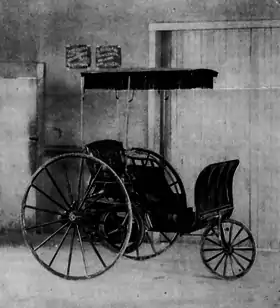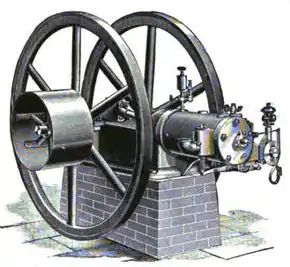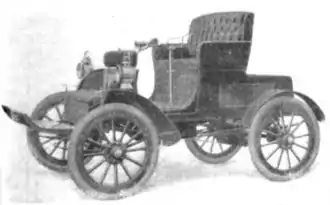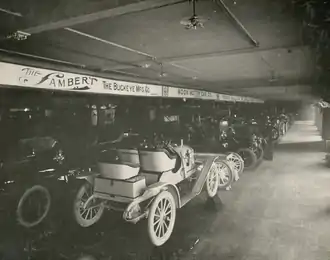Buckeye gasoline buggy
The Buckeye gasoline buggy also known as the Lambert gasoline buggy was America's first practical gasoline automobile made that was capable of being driven on roads. It was also the first available car for sale in America. It was initially a three wheel horseless buggy that was propelled by an internal combustion gasoline engine. This later was developed into a four wheel automobile that was mass-produced during the first part of the twentieth century. This was expanded into a line of trucks and fire-engines. The Lambert line of automobiles was manufactured with a gearless transmission.
 The 1891 Buckeye Gasoline Buggy | |
| Overview | |
|---|---|
| Production | 1890 |
| Model years | 1891 |
| Designer | John William Lambert, inventor |
History
John William Lambert made America's first gasoline car in 1891, according to a five-year extensive study by L. Scott Bailey, a well-known automobile historian, editor, and publisher.[1] The study found substantial evidence to enter this claim on Lambert's behalf.[2] The evidence from Bailey's study shows that Lambert successfully designed and built a gasoline engine automobile that he ran in the early part of 1891 in Ohio City, Ohio.[3][4] It shows that neither Henry Ford nor the Duryea Brothers have the distinction of building the first such practical working internal combustion gasoline engine automobile in the United States.[5]
In Europe Carl Benz and Gottlieb Daimler produced the first gasoline automobiles in 1885/1886.[6][7] The Duryea brothers made their first American automobile in 1893 and three years later started mass-producing cars at Duryea Motor Wagon Company.[7] Henry Ford started mass-producing cars in 1899 at the Detroit Automobile Company.[8]

Lambert initially worked on an internal combustion three cylinder gasoline engine in 1890.[9][10] He successfully tested it in the month of January of 1891 inside an 80-foot (24 m) farm equipment showroom he owned and managed in Ohio City, Ohio.[11] He did his first outside driving in late February of that year on the main street of the city.[10][12] Lambert's three-wheeled surrey fringe-top gasoline-powered buggy was his own design.[13] It had a four-stroke engine. The Buckeye gasoline powered buggy was a one-seat two passenger tricycle with a pair of large rear wheels for negotiating the rough high-center 1890s country roads.[14][15][13] It had a forward center small wheel for steering that was operated by the feet.[5][14]
Lambert designed a sales brochures advertising its specifications in January 1891. He mailed this brochure out to prospects in the first part of February 1891 with a price of $550.[1] Later in the month he was running his automobile on the main street of Ohio City.[16] Bailey points out there are several letters on file dated in the latter part of February and the early part of March 1891 requesting additional information on this horseless carriage that Lambert described in the brochure. Other letters of inquire continued, however Lambert ultimately was not able to sell any of three wheeled self-propelled vehicles.[5][17]

This three wheeled model had dry cell batteries and an electric ignition. The automobile had two speeds forward and none going backwards. A crowd gathered when Lambert operated his horseless carriage on the main street because it produced a lot of noise and belched smoke. The weight of the car was 585 pounds. It had wooden wheels with steel rims for extra wear. The carburetor was a surface vaporizer with a flexible diaphragm device. This was patented by Lambert on May 17, 1902. The original model cost Lambert over $3300. In December of 1891 this three wheel vehicle was lost in a fire when the grain elevator building that Lambert was having remodeled burned to the ground.[5][18]
Lambert decided in 1892 to manufacture stationary gasoline engines. That year he moved to Anderson, Indiana. He incorporated the Lambert Gas and Gasoline Engine Company for making stationary gasoline engines for farm and industrial use. He formed the Buckeye Manufacturing Company in 1893 to make automobiles.[19] He did experimentation and devised the Lambert friction gearing disk drive transmission that became the key feature on all of his future automobiles he would make. Lambert's first model design of the three wheel 1891 gasoline engine driven buggy was eventually modified and developed into the four wheel Union automobile which was first sold in 1902.[10][18]
A second factory plant was constructed in 1905 for the manufacture of the Union car. At that time the company changed its name to the Lambert Automobile Company and redesigned the automobile into a higher quality vehicle that they mass produced.[5][18] The company not only made gasoline engine street cars, but commercial trucks, fire-engine vehicles, railroad inspection vehicles, and tractors for farmers.[10][19][20]

The Lambert Automobile Company belonged under the umbrella of the Buckeye Manufacturing Company conglomerate group. It produced 2,000 vehicles per year on average from 1906 to 1910 with 500 employeers hiring more workers each year. The company employed over a thousand workers by 1910 and production increased to about 3,000 vehicles per year on average until 1916. In that year only about a thousand vehicles were manufactured. In 1917 when the United States entered into World War I the plant retooled to make equipment for the war. They then made projectiles, ammunition, wheels, and special purpose engines.[20]
Lambert produced only a few vehicles after the war was over. He realized that automobiles had to be mass-produced on a very large scale to be profitable.[10] The Buckeye Manufacturing Company group totally stopped manufacturing automobile vehicles and parts altogether by 1922. In the time of their production the manufacturing of the automobile was their main enterprise. The company always designed its own bodyworks and vehicle motors. Sometimes some of these were made to order by third parties and manufactured to Buckeye's specifications. The automobile interiors were of high quality upholstery and the final exterior paint job finish was fifteen layers.[20]
Festival
Lambert Days is a community celebrating that honors the life of John W. Lambert, the first gasoline-powered single-cylinder vehicle, and the world's first car wreck. This is an annual three-day event that takes place in Ohio City, Ohio, on the third weekend of July. Activities and events: Car Show, Art Festival, Flea Market, Sporting Events, Parade, Live Entertainment, and Lambert Automobile Displays.[21]
See also
Footnotes
- "Anderson's Automobile Age". Archived from the original on 2010-03-25. Retrieved 2008-12-19.
- Scharchburg 1993, p. 22.
- Huffman, Wallace Spencer (1967). "Indiana's Place in Automobile History". Indiana History Bulletin. 44 (2): 12.
- "Auto's 75th Anniversary of special interest Here". Anderson Daily Bulletin. Anderson, Indiana. January 12, 1971. p. 4 – via Newspapers.com
 .
. - Bailey, L. Scott (1960). "Historic Discovery: 1891 Lambert, New Claim for America's First Car" (PDF). Antique Automobile magazine. Vol. 24 no. 5. Heuss Printing. pp. 342–347.
- "Automobile History - Famous Automobile Makers". Retrieved 2008-12-19.
- "The History of the First Cars". Archived from the original on 2008-12-18. Retrieved 2008-12-19.
- Batchelor 1994, p. 18.
- Benton 1983, p. 517.
- Anthony Harrigan (December 27, 1976). "American Automobile Changed Our Lives". The Brownsville Herald. Brownsville, Texas. p. 6 – via Newspapers.com
 .
. - Madden 2003, p. 2.
- Scharchburg 1993, p. 23.
- Bill Swindler (November 10, 1967). "Would You Believe it?". Wilmington News-Journal. Wilmington, Ohio. p. 11 – via Newspapers.com
 .
. - Clymer 1950, p. 6.
- Smith 2002, p. 62.
- Bailey, p. 343
- Lucendo 2019, p. 1863.
- Dolmar, Hugh (1906). "The Lambert, 1906 Line of Automobiles". Automobile Trade Journal. Chilton Company. 10: 225–228.
- Forkner 1914, p. 385.
- Lucendo 2019, p. 1864.
- Mosier, Dave. "Lambert Days 2013". The Van Wert Independent. Retrieved December 11, 2020.
Sources
- Batchelor, Ray (1994). Henry Ford, mass production, modernizing, and design. Manchester, Maryland: Manchester University Press. ISBN 9780719041747.
- Benton, William, ed. (1983). "John William Lambert". The New Encyclopedia Britannica. 2. New York City: Encyclopedia Britannica.
- Clymer, Floyd (1950). Treasury of early American automobiles, 1877-1925. New York City: McGraw-Hill. OCLC 1004934361.
- Forkner, John La Rue (1914). History of Madison County, Indiana. Chicago, Illinois: Lewis Publishing Company.
- Lucendo, Jorge (2019). Cars of Legend. McFarland & Company.
- Madden, W. C. (2003). Haynes=Apperson and America's First Practical Automobile. Jefferson, North Carolina: McFarland & Company. ISBN 0-7864-1397-2.
- Smith, John Martine (2002). Auburn - The Classic City. Arcadia Publishing. ISBN 9780738524016.
- Scharchburg, Richard P. (1993). Carriages Without Horses. Chicago, Illinois: Society of Automotive Engineers. ISBN 9781560913801.